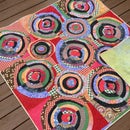Introduction: Mushroom Spore Prints
Making mushroom spore prints is so simple to do and the results are dramatic. What happens is that the spores fall down from the mushroom's gills and land right on a piece of paper instead of on the ground where we would never notice them, besides they get blown away very quickly by the wind. In just a matter of hours we are able to see a sort of x-ray or print of the gills, but made up of spores, it's pretty cool.
Step 1: Supplies:
- Fresh mushroom caps
- Sharp knife
- Bowls
- Gloves
- Paper of different colors
- 12 - 24 hours
Step 2: What to Do
- Play it safe and assume that any mushroom you are dealing with that did not come from the store is poisonous and treat it accordingly.
- While wearing gloves, find some mushrooms and carefully gather them, trying not to disturb the gills in the cap or getting dirt on them.
- Carefully - so as to not squish the gills - separate the cap from the stem; I used a sharp knife.
- Place the caps face down on paper, and cover with a bowl to keep any breeze from disturbing the process of the spores dropping from the cap onto the paper.
- Wait for 12 -14 hours and take a peak to see if you have a good print.
- If you don't have a good print keep waiting. It's a good idea to have a few of the same types of mushrooms because when you pick up a cap to see if the print is there you really can't put that cap down again on that print or it will smear.
Step 3: Variables
Depending on what you are going to do with your spore prints, such as photographing them, the paper you place underneath the cap will have a lot to do with how your print turns out. It is a guessing game to know if a white mushroom will produce white, light, black or green spores. Obviously, if you think you are going to get white spores you would not want to use white paper.
Sometimes I waited as long as three days to get a nice spore print.
Step 4: Different Surfaces
I tried using different surfaces to see the different effects. I used velvet - not so great. I tried wood, which I think has potential but the mushroom cap I used produced ugly green spores so some photoshopping was in order.
The first image in this 'ible was made by placing the mushroom on my filing cabinet which has a slick, shiny surface.
Step 5: And Now?
Now you have a bunch of beautiful mushroom spore prints (or at least know how to make them), and you are asking yourself what you can do with them. Well for sure you can ooh and ah over them but be careful of bumping the surface they are on or even breathing over them: they are ever so etherial and will just disappear all together if you blow on them.
In the world of science vs art, this process is done to collect spores so as to make more mushrooms; it's like collecting seeds. I tried that with Chanterelles and met with no success. The spores were orange and wiggly but not nice enough for prints to show off. After soaking the paper in water and pouring the spore filled water on the ground and waiting 3 years I still do not have Chanterelles.
For myself, I plan on making large silkscreens from my spore images to use for printing on fabric. Even though the images on the fabric will be much much larger than a real mushroom, the image is familiar to our eyes and I think it will look good. One day soon.













